Whether you’re a seasoned corporate executive, a business owner, or a budding entrepreneur, you’re busy. But whether you make hundreds of dollars or millions of dollars, there are always more steps to climb before you reach optimal business performance.
Utilizing the coaching tools offered by a seasoned business or executive coach can help you skyrocket to the top.
1.) But first, what’s the difference between business coaching and executive coaching?
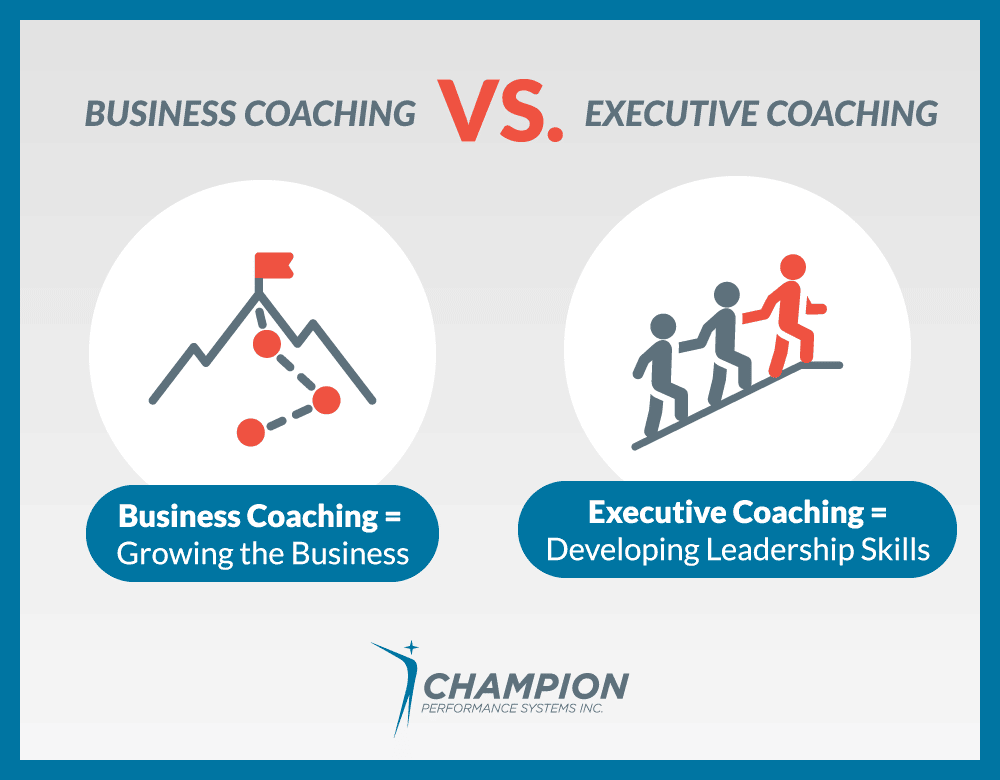
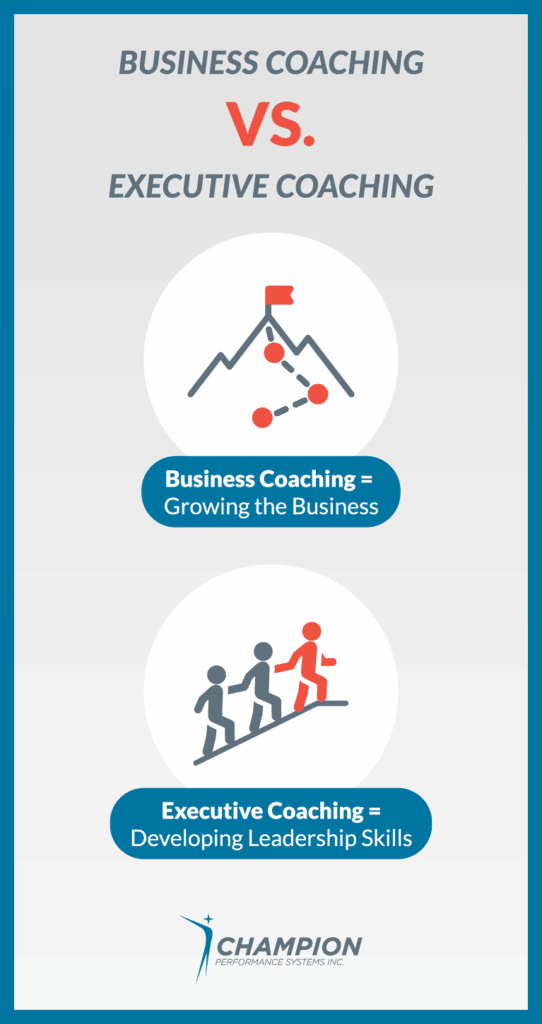
While there are fundamental similarities, and while the aspirational goal of organizational development is present with both services, there are some significant differences between them.
Business Coaching is about growing the business. Executive Coaching is about developing your leadership skill set so that you can lead your business more confidently.
Let’s first get a firm understanding of business coaching and how it can help you grow your business, expand your organization’s skill set, and improve your leadership team’s management style.
If you’re 100% confident that you know everything there is to know about business coaching, jump ahead to learn about how executive coaching differs.
2.) What is business coaching and mentoring?
Business coaching is the art of taking different expectations, challenges, dreams, and dilemmas and using them to establish goals, increase performance, create strategies, and increase revenue within your business. This is a different experience than having guidance from a mentor.
Business coaches provide personalized advice for your business – which is way more valuable than generic advice you’ll get elsewhere. Think about it like this: if you want to learn how to play a new instrument, having a skilled professional to teach you is much easier than trying to learn on your own.
3.) Why is business coaching important?
Many entrepreneurs, business owners, and managers feel that they can handle and grow a business on their own. They may even lean on online materials to help them from time to time. However, businesses both small and large need some guidance to help them learn and focus on what’s important.
Anyone can gather the inspiration they need, but turning that inspiration into a strategic plan is an art that business coaching can help you achieve – from beginning to end. By collaborating with a business coach, you’re encouraging breakthroughs in balance, impact, and business growth.
4.) What is the first meeting with a business coach like?
You can expect to meet with your business coach for one-to-two hours in the initial meeting. They’ll take this time to learn about you, your business, and the team. This knowledge will be used to help them tailor advice specifically for you. Other topics of discussion will include goals, strengths and weaknesses, and potential areas of improvement.
Then, your coach will work with you to create an execution plan for the items you’ve discussed. You’ll also establish a regular cadence for necessary meetings, whether it be for the individual or the team.
5.) What does a typical business coaching session look like?
Business coaching sessions are typically filled with reflection, observation, and practice. Reflection and observation will allow you to look back on the progress (or lack thereof) you’ve been making and get insightful feedback from your coach on how to improve.
These sessions are where you’ll express any dilemmas or problems that are preventing you from reaching your goals. It’s also the time to provide feedback to your coach to ensure that you’re getting the most from your coaching relationship.
What should I ask a business coach? When & how do you evaluate progress? – It’s important to have defined periods of reflection about the progress you’re making and determine what’s working & what’s not.
6.) How can you measure the success of business coaching?
What you measure will depend on your goals. Some goals might have key performance indicators that you can evaluate at the beginning and end of the process, while other goals might be measured through one-on-one meetings with members of the team.
Your coach will work with you to determine specific metrics that you want to change and the degree to which you want them to change. You can document these indicators and evaluate them throughout the process to track your progress.
7.) How do I choose the right business coach?
Prepare to make an investment in a coach who is willing to invest their time and knowledge in your business. Even if your only goal is “figure out my goals,” find a coach who is willing to help you create them.
Most business coaches have versatile skill sets that allow them to guide you through a number of situations. Narrow down the areas of your business that you know you want to work on the most and look for a coach who is particularly knowledgeable about those problems.
8.) Can a business coach really help increase workplace productivity?
Yes – A business coach can help you build a framework for your business that sets a stage for a productive workplace.
We are constantly adding more and more work to our plate. And as we stress about it, we pile on more distractions, whether we realize it or not.
“Ah shit, another meeting? I’m already too booked. I don’t want to do any of it.”
So you open your phone to forget it all. You check your notifications. You read an article. You scan Facebook. You clean your office. But guess what. These distractions aren’t only harmful to you. They’re harmful to the entirety of the workflow throughout the office.
Distractions are like dominoes. As soon as one person gives in, it starts a chain reaction. Distractions kill productivity.
Sure, technology should absorb some of the blame, but a lot of productivity is lost to human mistakes and negligence. A business coach will help you balance “distractions” with “doing.” Here are several common workplace distractions and some helpful ways to deal with them.
Phones
All the information we could ever need is located in our pockets all day every day. We get constant “dings” and “buzzes” from texts, emails, calendar notices, social engagements, and much more. While some of this is helpful, it’s also very interrupting.
How to eliminate this distraction:
Set your phone to silent, even if it’s only for a few hours. Having a few hours of distraction-free work can be incredibly therapeutic and productive.
Emails
You probably spend too much time digging through your inbox. Sometimes, you probably feel like it’s all you do. You check on project status, you monitor workflow, you send inspirational messages to keep morale high within your organization. But sometimes this can become overwhelming.
How to eliminate this distraction:
Write precisely. Boil the important points down into a digestible format, and let it go. For non-urgent projects and conversations, limit yourself to only a few interactions per day.
Coworkers
Good coworkers help us get through the day. They make us laugh and offer constructive criticism to help us push out our best work. However, sometimes they hinder us from doing our best work.
How to eliminate this distraction:
Close your door, and place a sign on it indicating when you’ll be available next. If you’re in an open office, wear headphones. Even if you don’t listen to music, people are much more hesitant to disrupt your train of thought if you have something covering your ears.
9.) Can a business coach help my team have more productive meetings?
Absolutely. Every single one of us sits through countless worthless meetings. A good business coach can help you develop strategies to change this. Far too many meetings are destined to deteriorate well in advance, and mostly by default.
There’s a tendency to overpopulate them with reports, issues, conversations, and numbers, and then walk out unfulfilled, or worse, resentful of the time it took you away from your “real priorities”! This attitude results in failure more often than not.
A proper coach can teach leaders how to properly prepare for quick, high value, and fun “do-it-and-get-out” meetings with the right people.
A Quick Coaching Session:
Step 1: Create / Establish the purpose
You need to create clarity with a purpose statement. Determine the why, who, what, and when. Why are we meeting? Who is attending? What needs to be discussed? When is it?
Clearly indicate this purpose so that the attendees who didn’t write it can still read it, make sense of it, and buy into it! Regardless of the frequency of the meetings (daily, weekly, monthly, quarterly, or annually) this purpose can be (and should be) set.
Step 2: Determine / Clarify the value you’re seeking
If you can’t get clarity about the value of the meeting, then why are you having it? How does the value align with the purpose – not just of the meeting, but with the company’s goals and aspirations? Where is the value?
The value in meetings should be related to:
- Vision / Goals
- Numbers / Data
- Timelines / Deadlines
- People in attendance
- Actions / Accountability
Know what materials and documents need to be shared in advance.
The lens through which we look at the meeting will determine its functional components.
For example:
- Do we need visuals?
- Is there reading that needs to be absorbed in advance?
- Will it require a PowerPoint?
- Will everyone need their laptops?
- Does the meeting environment matter?
- Do we need to meet in person?
- Better yet, can this all be accomplished in an email?
Remember: No Surprises!
If any necessary information needs to be reviewed prior, this needs to be sent out with ample time for all to read and absorb. However, be very clear when sending these materials. State what you want from the reader either prior to or in the meeting.
Step 3: Build / Set the Agenda
It might sound crazy, but setting an agenda is the third thing you need to do. You can’t schedule a 15-minute phone call and then determine that the purpose is to create an entire business strategy for Q4. You’re setting yourself up for failure.
General categories for effective agendas:
- Opening statements to set the tone and remind all of the purpose.
- “WWW” review: how’d we do since the last meeting?
- Content discussion and decision making.
- Speaking topics along with who’s leading that discussion. Include the approximate time required.
- Preparation of visuals for on-screen viewing, if necessary.
- Clarity check.
- Closing statements to wrap it all in a bow.
Step 4: Figure out executables
Now that you know what needs to be done, there needs to be a commitment from the people who agree to execute each task within the scope of the project. This needs to be recorded as it happens in the meeting with the “WWW tool” (who-what-when). Get crystal clear on the task, who the champion is (and others assisting), and the deadline for completion.
Be sure to review it in detail at the end of the meeting to ensure clarity. Often, action items are captured at the beginning of and during the meeting, and by the time the meeting is about to close and the tasks are reviewed, no one knows what they meant.
After the Meeting:
Instead of sending out “the minutes” as an attachment to those who didn’t attend the meeting, include a link to the document where the right people can go view. This keeps your email short (EMAIL RULE: don’t make me scroll). The only thing that should be attached is the Who-What-When (WWW) with champions, actions, and timelines.
Before you get back into your own whirlwind, do a brief evaluation.
- What worked?
- What didn’t?
- What needs to change?
Then bring this up at the next meeting. Ensure your first item on the agenda is a review of these questions. It’s amazing what happens to accountability when task champions have to report openly in front of their peers how they made out with their tasks
If you need help with determining any of these factors with the intent to grow your business, feel free to reach out for some help.
10.) Can a business coach help me capitalize on consumer expectations?
Our world is tired of service. We now crave experiences. In the obstacle-laden world of customer service, everyone’s expectations are constantly changing.
This “service expectation” is usually set by a genius executive that drives their team in the right direction, and most other businesses struggle to keep up. For the majority of companies, the gap between expected and delivered customer service is widening at an alarming rate. This gap creates stress not only within the organization but also between the customer service rep and the customers themselves.
If the consumers aren’t happy, no one is.
As a business leader, now is the perfect time for you to buck up and join the ranks in the next round of successful entrepreneurs. With the right perspective, the proper business coach can help you get there.
11.) Can a coach help me differentiate between customer service and customer experience?
The “experience” is obtained when you go above and beyond the mass consumer’s expectations. It’s the human connection. It’s what makes them a friend first and a customer second. It’s what makes you a trendsetter instead of a trend follower.
Organizations that are attached to a strong purpose and put the right people in position to create it, will be able to get out in front of it.
If businesses really want to offer true, human experiences to their customer base, they must determine what their company’s baseline experience is. This can be obtained through a “secret shopper” mentality.
Be the customer. If you own a grocery store, shop there. If you own a telecommunications entity, take a few calls. Then change the fundamentals of the customer service aspect of your business until you’re wowed by your own team’s product or service.
What is your team doing to understand exactly what your customers want? How are you exceeding this expectation? What are you doing to put your team in the position to deliver the experience consistently? A business coach can help you answer these tough questions.
12.) Can a business coach help me determine my SWOT?
SWOT is a business acronym that stands for Strengths, Weaknesses, Opportunities, and Threats. If you don’t revisit your SWOT on a regular basis, you can’t properly assess business growth opportunities as they come through the pipeline. Through business coaching, you can find it.
Look at it this way:
If you only monitor your strengths and weaknesses every year (if ever again), you could have been straying away from “your geographical north” for most of that time period, and totally unaware… until it’s too late!
What course corrections are you making in order to close the gap between activities and results?
13.) Can a business coach help me measure against KPI?
KPI (Key Performance Indicator) is a well-known acronym in the professional world, and many businesses measure against them with the help of business coaches.
Key performance indicators are almost always lagging, and they tend to be based on financials. Too many organizations are disproportionately focused on these financial KPIs and don’t have a healthy balance of measurements in place for the rest of the business.
It’s a breakthrough for a leader or a team to understand that they need to focus just as much on leading indicators as lagging — there must be a balance of the two because the leading influences the lagging.
14.) Can a business coach help us find our purpose, vision, and mission?
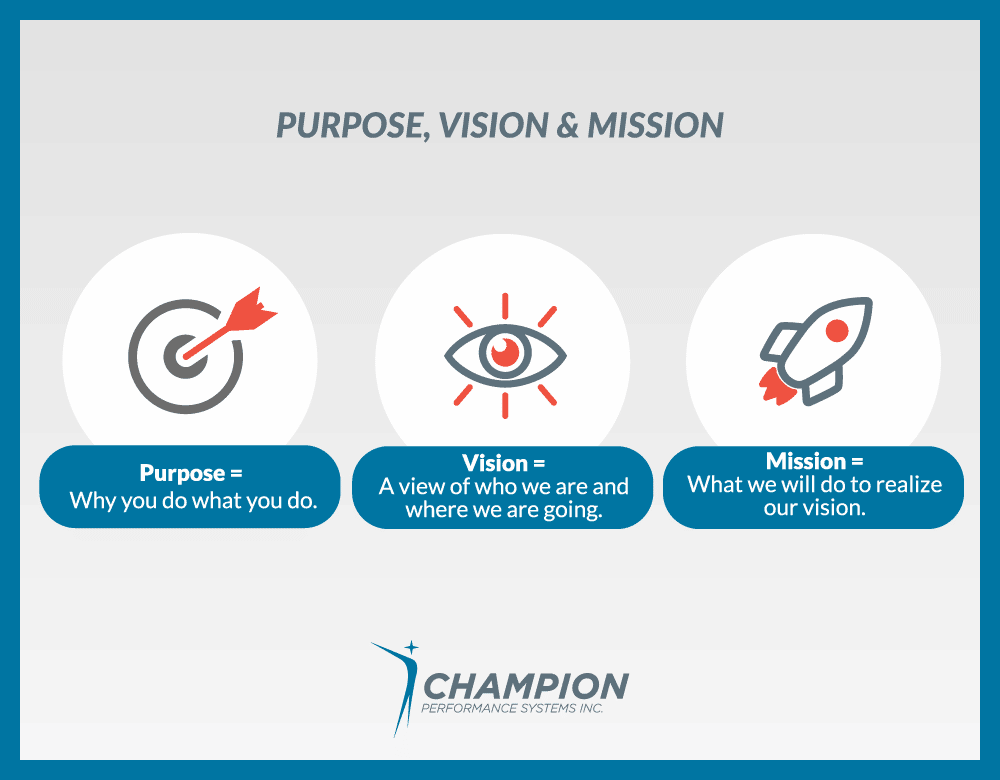
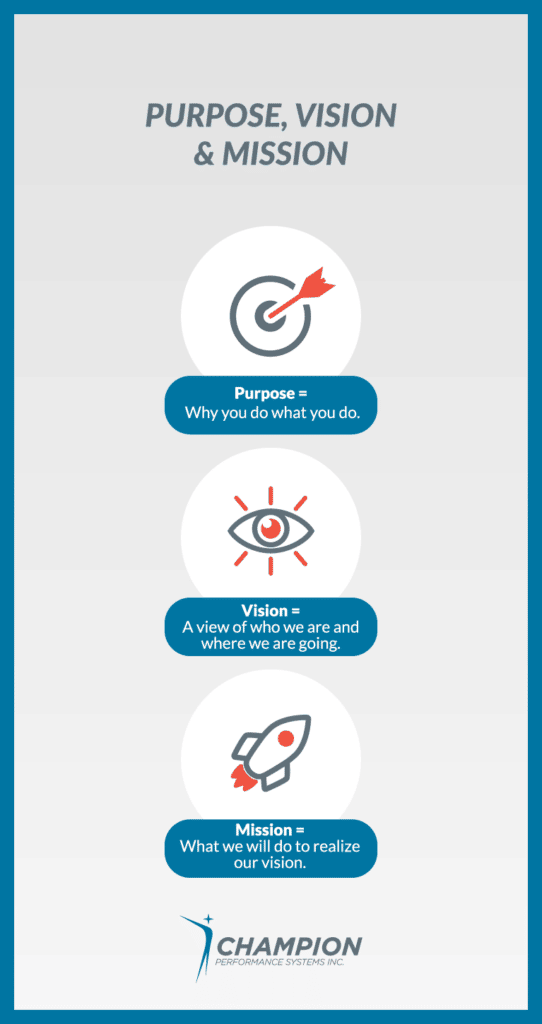
Many organizations take years to discover and implement company vision and mission statements that are truly unique to their business. When this happens, their focus tends to shift from “discovering professional beliefs” to “avoiding controversy,” which then results in general appeal, but doesn’t provide any company awareness.
This goes directly against the entire point of a mission statement, which should be a concise reflection of your company’s fundamental purpose.
Purpose: This is “why” you do what you do. It’s what gets you out of bed in the morning. It’s far more powerful than Vision and/or Mission. It’s your reason for being.
How does purpose differ from vision and mission?
Vision: A view of who we are and where we are going
Mission: What we will do to realize our vision.
You need them all, but Purpose is where it needs to begin and be based on! After a few business coaching sessions, you should be able to find yours.
15.) Can a business coach help my company determine our core values?
Every business knows it’s supposed to have core values, so a lot of time is spent creating them. However, this usually results in lofty and hollow core values, like ‘respect’, ‘integrity’, and ‘excellence.’ Empty and meaningless value statements like this do nothing to inspire or progress your organization. They actually tend to decrease employee morale, alienate your customers, and undermine your executive credibility.
Signs Your Core Values Aren’t “Core”:
- You’ve written down your professional values, but you aren’t actively practicing or promoting them inside and outside the organization.
- Your employees’ behavior contradicts your stated values.
- Your values are aspirational, meaning they represent behavior you wish was exemplified by yourself and your employees.
- Your values only reflect the minimum behavior and standards required of employees.
If any of these scenarios sound familiar, your value statements need an overhaul, and a seasoned coach will help you do it.
16.) Can a business coach help build my team?
Bruce Tuckman created the team development model in 1965, and it’s still used by business leaders and coaches throughout the world today. It’s simple to understand, but it’s difficult for many to implement. A business coach can help tremendously. Here’s the basic steps:
- You CREATE your team.
- You DEVELOP your team.
- You WORK toward a goal.
- You SURPASS a goal…maybe.
Every team wants to reach that final stage: Surpassing a goal.
However, very few teams make it. This is typically where a business coach would be useful.
An orchestra can’t grab random people off the street and tell them to perform a symphony. This level of performance and professionalism takes time, talent, and most importantly, teamwork. Sometimes leaders aren’t willing to take the time, grow the talent, or promote that teamwork that is necessary to reach that final stage.
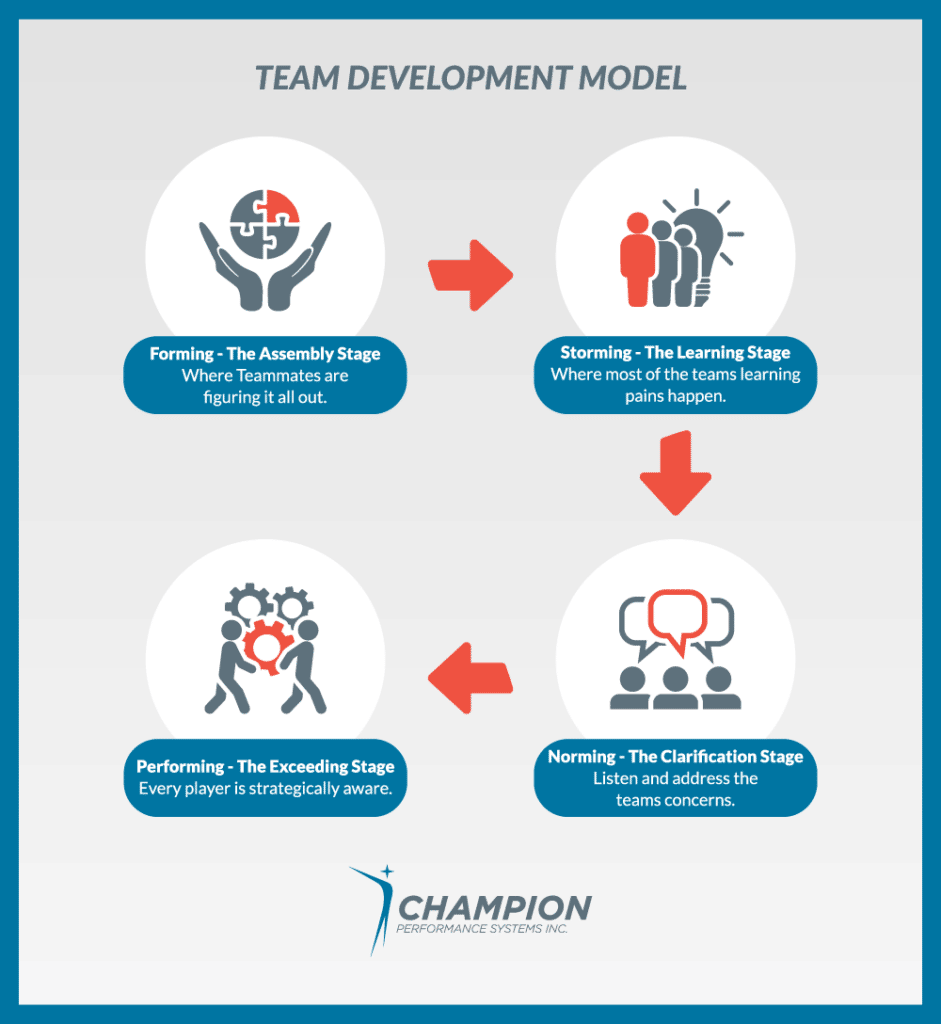
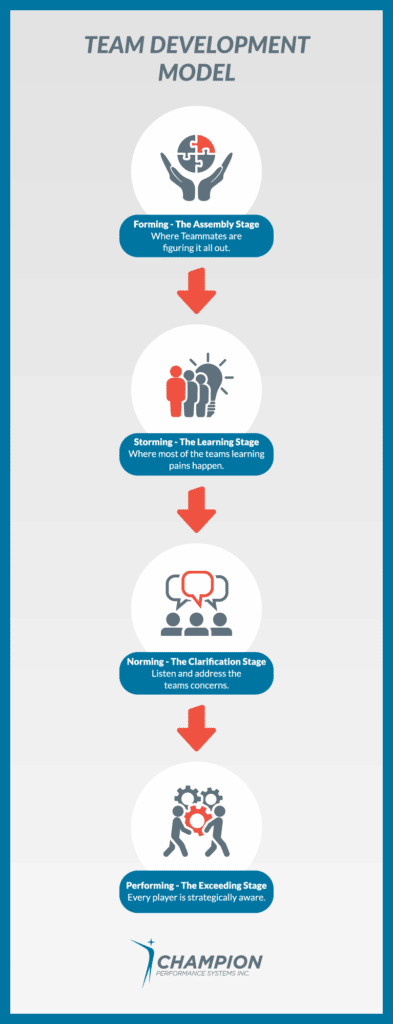
Here’s the Team Development model explained by a business coach:
Forming – The Assembly Stage
Expect new hires to lean heavily on leaders as they become acquainted with the new environment and acclimate themselves with the company, leadership, purpose, its objectives, and client relationships. It’s typical for standard business processes to be ignored, and you’ll often find that team members test the leniency and tolerance of the leader. Essentially, this is the stage where teammates are “figuring it all out.”
You’ve graduated from the forming stage when you’ve structured the optimal team for the business strategy that lies ahead. Without this ideal team, the entire development process can be extremely difficult.
Storming – The Learning Stage
The Storming Stage is where most of a team’s learning pains happen. It’s a difficult stage that can create positive or negative experiences for businesses. Most of the time, this negativity occurs because leaders don’t pay attention to the team development process and the weaknesses that are discovered within it.
Throughout the storming stage, factions may start, and many times, teams may crash and crumble from the unfamiliarity of the situation. However, both the leader and the team can learn from these obstacles and adjust accordingly.
Norming – The Clarification Stage
Listen to and address concerns as your team approaches and reaches consensus. After you establish clarity, and as your team figures out how to work together appropriately and efficiently, your main goal as the leader is to recognize and applaud this efficiency. Commitment and unity are critical in the Norming stage.
Performing – The Exceeding Stage
Think of the orchestra. Every player is strategically aware. The conductor oversees the performance, but each musician’s confidence in their ability to play a specific instrument flawlessly contributes to the spectacle. Now there’s a focus on achieving and surpassing goals. In the orchestra’s case, it’s creating stunning, sonic beauty. Without their confidence and poised coalescence, they couldn’t reach their goal. They share the vision. They share the motivation. They share the drive. They share the stage.
The bar is set high, but they achieve their goals when the team can lean on each other and work together. A few sessions of corporate coaching might help you realize your vision through your team.
17.) Can a business coach help us establish a company culture?
Yes – and it’s an important factor for every business. Every unique business has a company culture whether they realize it or not. Nike does. The local coffee shop does. Your business does. However, far too many businesses assume that culture is uncontrollable and unchangeable.
The Benefits Of Establishing A Positive, Purposeful Culture:
- More interest during the recruitment process – An interesting, purposeful culture yields innovative applicants. Promoting your culture in job descriptions and on your company website is a great way to gain interest from potential recruits before you even interview them.
- Offering non-monetary benefits saves you money – Not all benefits need to be monetarily-based. Many individuals appreciate environmental and small benefits like shuffleboard and the opportunity to play other games at the office. These tactics are useful for small or growing businesses that can’t yet afford to offer their employees above-market salaries, retirement plans, or juicy bonuses.
After several successful coaching sessions, you’ll more than likely be able to create employment-based jealousy in the market is usually a strong move.
Now that you understand the benefits of utilizing a business coach to help grow your business, let’s dive into how Executive coaching can help improve your leadership skills. After all, the business can’t grow without a good leader.
18.) What are the goals of executive coaching?
- Increased Clarity and Focus– It’s easy to get so busy and involved that you lose time to focus. With each executive coaching session, you’ll gain clarity, focus, and be able to spend time on more important things.
- Goal Definition – Defining goals isn’t always easy or simple. Unbiased perspectives from your coach will help you develop a solid plan for both your personal and professional goals.
- Strategy Creation – With honest observations from your executive coach, you’ll be able to reflect on & refine your personal and professional strategies. This will help to inspire a proactive environment for you and your team.
- Increased Performance and Revenue – Your coach will help you eliminate the habits and patterns that are underutilized and the ones that keep you from performing your best.
- Accountability – Things will come up that try to distract you from your goals. Your executive coach will keep you on track and offer you advice on handling the things that may cause you to lose sight of your goals.
19.) Why should I work with an executive coach?
In an anonymous survey, the Harvard Business Review found that 68% of CEOs surveyed were not fully prepared to take on the role of a CEO. Some seek executive coaching when they’ve just stepped into a new role with bigger responsibilities, and some seek it because they have an area of leadership that they’d like to improve on.
For example, they might be good at strategizing but need help with leading the team. Regardless of industry, working with an executive coach will allow you to see yourself clearly, learn new ways to respond, build more meaningful relationships, and achieve what you want. Becoming a better leader isn’t just about your goals, it’s also about learning how to achieve betterment for your company.
20.) How do I prepare for an executive coaching session?
Think about your long-term objectives. What do you want to learn from your executive coach? What skills do you want to improve on? How do you want to impact your company?
Open up to new perspectives & ideas. Your coach will have different ideas than you do, and that’s exactly what you want. Hearing a different viewpoint on the things you want to work on can be extremely helpful. It will also allow you to see yourself how others see you, which offers another valuable viewpoint.
21.) What does a typical executive coaching session look like?
You’ll establish a regular cadence of executive coaching sessions with your coach. These sessions will progress over time, starting with goal setting, strategy development, and reflection on the progress you’ve made. With each session, be sure to talk to your coach about the challenges you’re encountering. These sessions are meant to be open & helpful, so express any feelings or ideas you may have.
22.) How long does it take to see results from an executive coach?
One session with an executive coach probably won’t fix all of your problems. These relationships last for several months, and you’ll start to set goals & objectives right away. Once you & your coach set a strategy for those goals, you will start seeing small results as you overcome obstacles. Even if a small result is extra time in your schedule from passing a task to another person, you’ve gained something you didn’t have before. These small results add up over time to lead to reduced stress, increased work efficiency, increased morale, and sharper focus.
23.) What characteristics should I expect from an executive coach?
Here are just a few of the many characteristics that make an excellent business coach.
- Patience — the business environment is complex, not all “aha” moments appear immediately
- Curiosity — excavating inner knowing takes a lot of probing
- A strong presence — getting to know you often on a level that few people in your life understand
- Good listening skills — in fact, the client should be doing 70-80% of the talking while the coach is only doing 20-30% of the talking
- Asking you plenty of “what” and “how” questions – (i.e. What makes you say that?, What options do you have?, etc.)
- Accountability — a powerful coaching partnership will offer a level of focus and accountability you can’t muster up on your own (sometimes it just takes a little nudge)
What you shouldn’t expect from an Executive Coach
- Dropping hints – (A.K.A subtly telling you what to do).
- Referring to themselves – (i.e. This is what I would do, I have a client that did this and it might work for you, etc.) — remember, it’s not about them.
- Making assumptions – listening and talking in their own head.
- Rushing you to make a decision – tackling difficult issues may take time.
- Being the first person to speak – a good executive coach will listen more than they talk.
Ultimately, coaches challenge your thinking by asking questions designed to help you see opportunities in ways you never have before.
When done well, these coaching skills will transfer to you, the client. It’s equally important for every good leader, CEO, or business owner to learn how to “coach”, too, so they can lead their own people and teams just as effectively.
24.) What’s the difference between coaching and consulting?
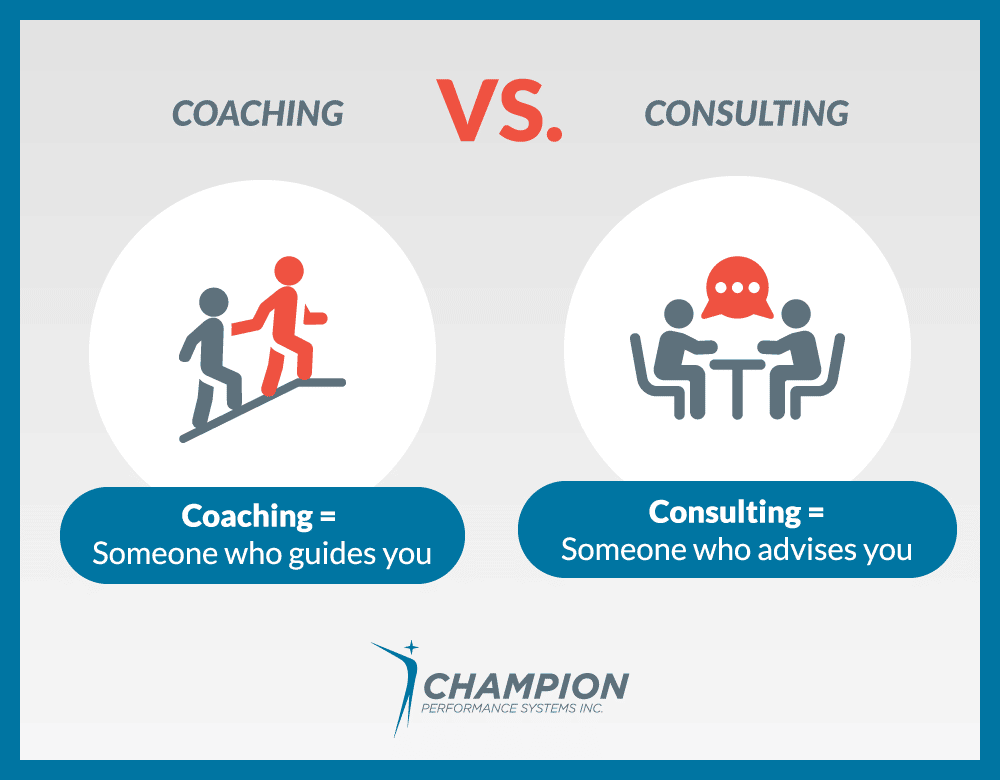
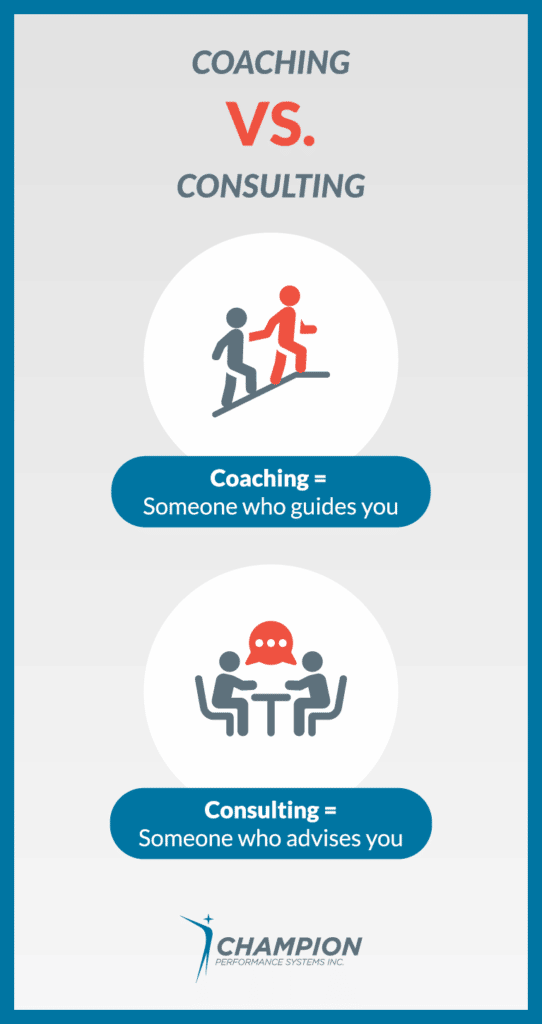
A coach may have some ideas as to what they think you should do, but executive coaching should be about guiding discovery and allowing the client to figure it out for themselves.
That’s the difference between coaching and consulting, being guided and being advised, being externally motivated, and being internally inspired.
“Hey coach, what do I do now?” This seemingly harmless question can be quite the opposite, especially if you’re a leader, CEO, or entrepreneur who’s hired an executive coach to help evolve yourself and advance your business.
Big problems can stem from asking this question. If an executive coach tells you what they think you should do and you execute their solution. Then the problem becomes a question of who owns the result.
It’s probably going to be more the coach owning the result than it is you, and that’s when the line between coaching and consulting becomes blurry.
You (the client) won’t be able to fully own the process of coming up with and implementing the solution.
When you’re inspired to figure out the answers for yourself, you get to experience that “aha” moment — the moment when the light bulb goes off and clarity becomes king. If you don’t have that clarity, you have nothing. And once you’ve achieved that moment, you’re going to own whatever action comes as a result, not the coach.
You’ll be more inspired, more driven, and have more power and energy behind the decision because it was yours, not someone else’s.
So, if a coach is telling you what they think you should do, then really you’ve hired a consultant. If you’re working with a good executive coach, don’t expect to be advised if/when you ask, “What do I do?” After all, no one knows your business better than you.
Great executive coaches can balance between being a consultant and a coach. And that’s the art of coaching — being able to seamlessly switch between the two when necessary.
So, when you hire a coach, don’t expect to be told the answers, expect to be inspired to find them on your own. After all, the wisdom is within.
25.) Can an executive coach make me a better leader?
He or she will do their best. One of the first things a coach will help you do is define the difference between arrogance and confidence, two characteristics that frequently get confused by those residing in the C-suite.
Arrogance vs. Confidence
There’s a big difference between arrogance and confidence, and it’s apparent in the attitude displayed toward the outcome of your endeavors.
An arrogant person will argue that the mistake would not have been made if a certain individual or obstacle wasn’t a driving force behind the misstep. This person will likely use the same tactics on their second attempt.
A confident person will accept that their failure is, in fact, their failure, and he or she will take note of their tactics that led them down the wrong path. They will then use this as a tool to create a new strategy for success.
If you want to be successful, learn how to get uncomfortable. Get rid of your arrogance. This process will build confidence and the ability to laugh about your mistakes.
26.) Can an executive coach help me prioritize my professional life?
If you’re having trouble prioritizing your workload constantly rearranging your schedule, it might be time to talk to an executive coach.
- You absorb too much responsibility.
- You sacrifice the quality of your work in the effort of saving time, eliminating the personal satisfaction you get from high-performance.
- You throw away tasks that might be worth completing at a later date.
It’s tough. Prioritization and scheduling remain some of the most bothersome obstacles on the path to business and personal success.
However, these issues can be fixed by understanding how to adjust your priorities based on two metrics: Importance and Urgency.
Here’s how some executive coaches help their clients ramp up productivity while removing stress:
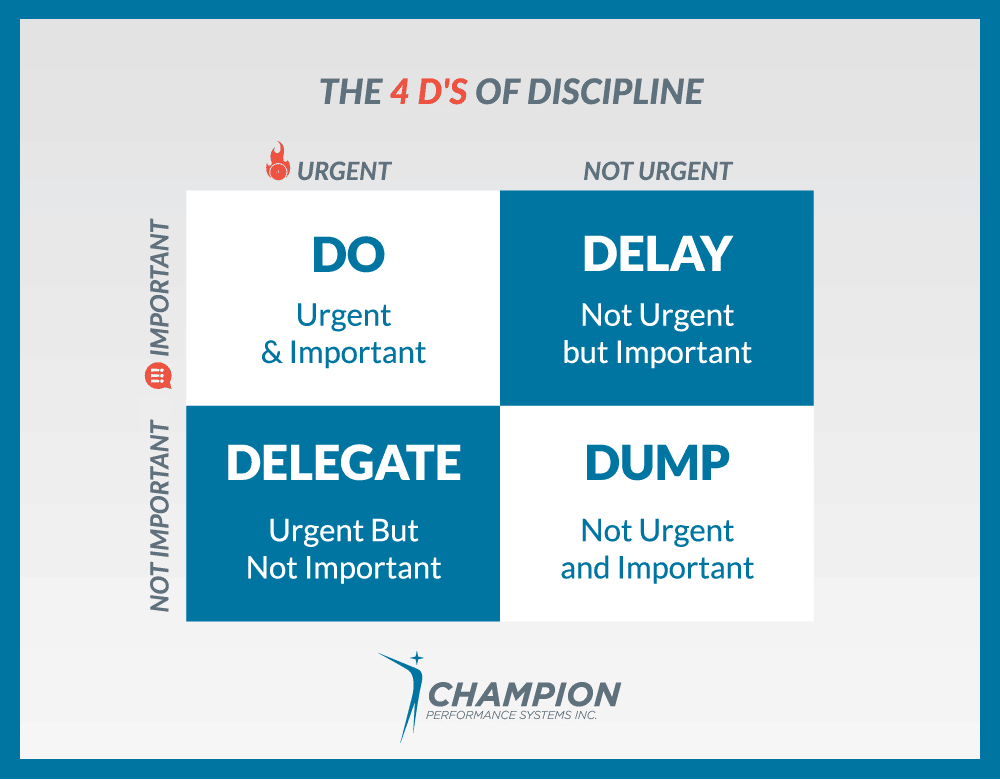
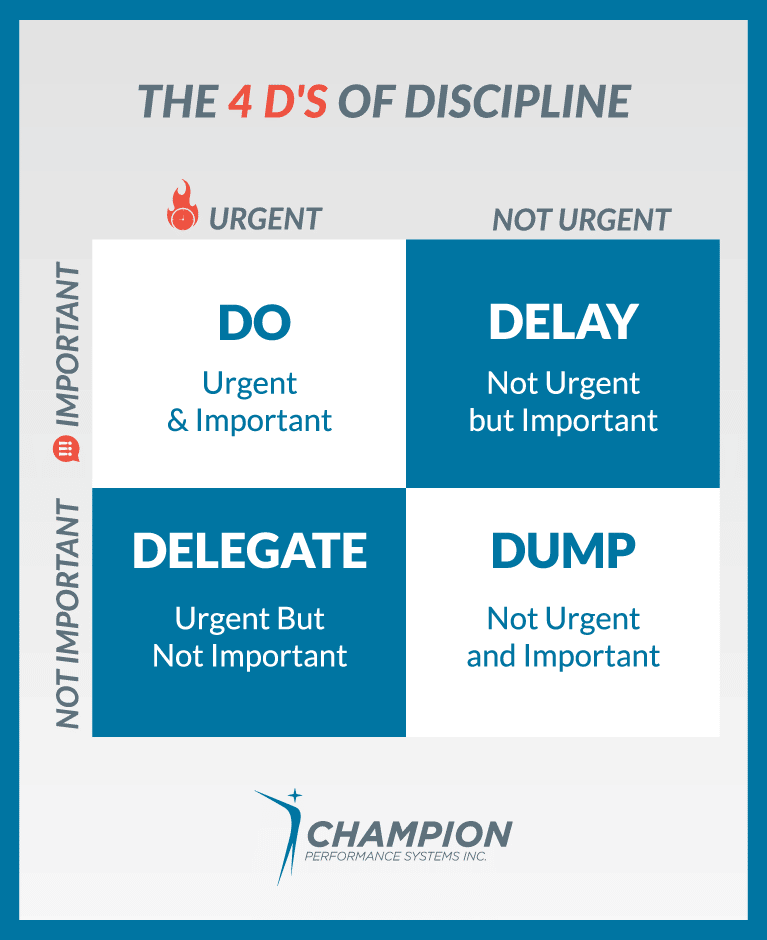
“The 4 D’s of Discipline”
The “Do” Quadrant
Urgent & Important
Complete the task now.
The projects that belong in this quadrant are crucial for business success and should be completed thoroughly and with efficiency.
The “Delay” Quadrant
Not Urgent but Important
Schedule it for later.
This task is relative to your goal, but it doesn’t necessarily need to be completed right now. Concentrate your time and effort on the tasks you’ve placed in the top left quadrant.
If your “to do” list isn’t accompanied by a methodology for implementing these tasks, they can typically be moved here.
The “Delegate” Quadrant
Urgent But Not Important
The Quadrant of Deception.
In business, we consistently confuse “urgency” with “importance.” Because of this, we scramble. We rush to complete projects, and the effort that could be used to complete tasks in the “Do” quadrant gets displaced. Understand your limitations and delegate accordingly. There are most likely employees within your organization who can take this project off your plate. Remove some stress, and return your focus to the top left quadrant.
Here’s the thing. If you trusted your employees enough to hire them, you can trust them to carry out the task with expertise and efficiency.
The “Dump” Quadrant
Not Urgent or Important
Do you really need to worry about this task?
If the completion of this project isn’t going to remove stress or help you reach your goal, then there’s a great likelihood that using time and energy on this task is a waste of time.
With an executive coach, you can start arranging your busy schedule appropriately. This process of time management and work elimination will help smooth your day-to-day workflow and decrease the stress of scheduling.
27.) Can an executive coach help me build and execute a strategic plan that will help me achieve my goals?
An executive coach can help you set both short-term and long-term goals.
It’s easy for leaders to become attached to the outcome. To the final result. To the big “W.” With the increased interest in “goal-setting and forgetting,” teammates are often left in the dust.
Spending time getting acquainted with your team’s weekly and daily schedule will help you understand whether or not your expectations are realistic and in-line with your ultimate objectives.
Goals are very important, but if you don’t know how you got there, did you really reach them?
An executive coach can help clients create and structure time-sensitive goal breakdowns like this, and in this order:
- Three-year goals
- Then Annual goals
- Then Quarterly goals
- Then Weekly goals
- Then Daily goals
While long term goals are drafted first, they won’t be the first to be tackled. These larger, often more intense goals are created to help you develop an ideal strategy of smaller, actionable items that push you and your company along the desired growth trajectory.
Basically, after you think big, learn how small actions and changes to behaviors can build the momentum you need to get there.
Establish a Three-Year Goal
After you’ve watched your team make progress with how each employee works with one another, how they prioritize tasks, how they meet deadlines, and how they handle certain stressors, you can be confident that the goal you’ve set is ready to be tackled.
Most importantly, an executive coach will help you create attainable personal and professional goals.
Establish Annual Goals
Your business strategy might change as new projects arise, but knowing how to handle that change is what is going to keep your employees’ momentum going! This will take your business to new heights.
Establish Quarterly Goals
Which teammates should be repositioned? What did we do correctly? How can we improve?
Similarly, every company leader needs to know they’re ranking amongst competing businesses.
- Which employees need to be moved to better suit their talents and interests?
- Are projects being disbursed properly?
- Are you remaining profitable, or are you struggling?
Establish Weekly Goals
You need to understand if someone on your staff is struggling to finish a project. Are they getting worn out? Do they need help finishing the task?
Establish Daily Goals
You need to create and implement a team development strategy that is constantly monitored and adjusted for peak performance.
Leaders who don’t pay attention to their team’s process and daily strategy will eventually create larger, lofty goals that are deemed “impossible” by the staff.
This causes tremendous burnout and quick turnover, both of which are avoidable by creating attainable goals that inspire employee confidence. Confidence breeds focus, and focus breeds efficiency and improved business performance.
While a concentration on reaching business goals is fundamental for organizational development and success, the end should justify the process, and you need to be able to understand exactly what that process was. Remember, just because you’ve set a goal doesn’t mean you’ve set it appropriately. So don’t neglect the process.
What’s preventing you from achieving your goals?
28.) Can an executive coach help me create a high-performance organizational culture?
An executive coach can help you come up with a plan to find and hire the right people for your team.
All leaders talk about the importance of identifying core customers and core values. But what about your core employees? Your most important resource is your people, and here’s why:
The average cost of a bad hire is estimated at 30% of the employee’s first-year earnings. This can scale up to 15x that employee’s annual salary. An executive coach can help you cultivate the highest-performers within your market to help create a highly-productive, organized culture.
5 ways an executive coach can help you Identify & leverage untrainable skills
He or She Will:
- Help you identify your current top talent
- Help you understand their most admirable traits
- Help you define the traits
- Rank and score your current personnel
- Utilize the results and help to implement these changes to your hiring framework
Imagine if 100% of your employees exemplified the majority of these core, untrainable skills.
Taking the time to find and hire the right people — the ones who really gel well within your culture — has been proven to have exponential results for the company over time, regardless of industry.
29.) Can an Executive Coach help me turn my failures into growth tools?
Failing might not be the quickest way to grow, but it might be the best way. Learning what not to do is just as important as any other success-preventing obstacle. If you can learn to remove the fear from your actionable processes, failure simply becomes research. An executive coach can help you turn those failures into research.
Here’s a direct quote from Michael Jordan, perhaps the most highly-respected basketball player in history:
“I have missed more than 9,000 shots in my career. I have lost almost 300 games. On 26 occasions, I have been entrusted to take the game-winning shot, and I missed. I have failed over and over and over again in my life. And that is why I succeed.”
Sometimes you have to break a bone. Sometimes you need to play in the mud. Sometimes you have to eat an investment. And sometimes you have to question the rules.
Since people are naturally attracted to successful individuals, we instinctively want to showcase those positive qualities. But we’re afraid of what our friends and family will think when we don’t live up to their expectations. Most of the time, we fail to realize that our own expectations are usually much higher than others. Keep this in mind as you continue through the process, and it will help alleviate the stressors of proving to everyone else that you’re a successful person.
Failure provides direction, and an executive coach can help you follow that direction you’re leaning into.
Here are some questions your coach might ask you in regard to failure and fear:
What are you afraid of?
Determine what’s preventing you from taking risks or overcoming your toughest challenges.
What risks should you take?
Discover what personal and professional projects you need to accomplish in order for you to feel confident in yourself and at your place of employment.
What’s the worst that could happen?
Absorb the idea of the worst potential outcome, and ready yourself to tackle the project.
What did you learn?
Figure out which processes can you eliminate from your next attempt.
What’s next?
Prepare yourself for your second…or third…or fourth…endeavor. You got this!
30.) Can an executive coach help me improve my communication style?
Yes. As a business leader you have to be able to communicate effectively with others. If you’re not connecting with the team in the right way you won’t achieve success.
Avoiding clarity is one way to streamline non-productivity.
So many leaders send mixed messages every single day and don’t even realize it. Communication is key, and it’s your job as a leader to unlock clarity. An executive coach can help.
After you leave the conference room, you don’t want your employees looking over at one another in confusion, saying “What the hell did he just say?”
Confusion is always avoidable. Sometimes we just try to avoid it in the wrong way. It’s not always about how you most comfortably relay information. It’s about how your employees absorb it.
So if you learn to contextualize each situation based on the listener, and if you can appropriately adjust your gestures, facial expressions, tone of voice, vocabulary, and intent, you’ll realize how much time is saved and how much productivity is increased. What mixed messages are you sending?
Situations Where Miscommunication is Most Prevalent:
- When the magnitude and importance of the topic is very high
- When there’s emotion involved
- When there are conflicting views
You might have thought you’ve found the perfect word or phrase to emphasize your point, but guess what. According to Dr. Albert Mehrabian, the author of “Silent Messages,“ only a small portion of communication is established by actual words.


55% of Communication is Non-Verbal:
- Your gestures
- Your appearance
- Your physical stance
38% of Communication is About your Voice Inflection:
- Your delivery
- Your emphasis
- Your potential sarcasm
7% of Communication is Based on the Words Themselves:
- Your vocabulary
- Your diction
- Your sentence structure
So based on this data, if a text or email contains an emotional slant, and if there hasn’t been context established, there’s a 93% chance that your message will get misinterpreted.
Pretty crazy, right? It almost seems unbelievable. However, if you do this exercise with your team, you’ll immediately understand why these numbers are so staggeringly different from what you’d expect.
Try this voice-inflection exercise:
The emphasis in each variation of this sentence will be shown in bold italics (since you can’t hear me). The potential interpretations of each sentence will be listed below it.
1. “I didn’t say you had an attitude problem.”
Okay, so who said it then?
2. “I didn’t say you had an attitude problem.”
Alright. Who has one then?
3. “I didn’t say you had an attitude problem.”
Wait, are you saying I just developed one out of nowhere?
4. “I didn’t say you had an attitude problem.”
Well, what kind of problem do I have?
5. “I didn’t say you had an attitude problem.”
Wait, so you’re saying that it could be better, but that it’s not a real problem yet?
Be very intentional with your physical communication.
- Be present
- Look them in the eye
- Sit up straight
- Face the person
In a leadership role, communication is absolutely crucial. If there’s potential ambiguity or even the slightest emotional tone, everything you say can be easily misconstrued.
But if you’re open to a little bit of scrutiny and a few justified suggestions, you’ll notice a huge difference in the way your team understands you, and it will put them in a much better position to implement your ideas.
31.) How does an external communicator create a level playing field for my employees?
The Player-Coach model doesn’t work in a team meeting environment, and that’s exactly why you need an external facilitator.
If you’re a leader, you know that you can’t be everywhere and everyone at once, even though you’d like to be (and you’ve certainly tried). How’s that working for you?
You want to watch the work get done, and you also want to get your hands dirty with the execution, because that’s how you got to be where you are today. However… what got you here certainly won’t get you there!
You want to be a player and a coach – often at the same time, especially in important team meetings (e.g. planning meetings and/or retreats). But unfortunately, when you try to be both, you really can’t succeed at either (e.g. chase two chickens and catch none…) This doesn’t work, especially when you’re hungry;)
In order to facilitate conversations properly, especially in team environments, you feel you have to assume a leadership role. Understood and agreed. But what does that look like?
If you keep your “CEO-I’m-responsible-for-everything” hat on, it often stifles the potential magic of true consensus and teamwork. People will hold back out of fear of not being heard. They’ll also feel that you’ll just make the final decision anyway – so why bother?
You can’t effectively switch back and forth between giving and taking orders, between being on and in the business and/or situation… between being a player and a coach.
It blurs the lines, confuses your team, and can seriously compromise performance, not to mention culture. But there’s a solution.
Find, hire, and engage a strong external facilitator. And when you find a good one, work with this person to set the stage for success, then “trust the process”! You won’t regret it!
6 Reasons You Need an External Facilitator:
1. It levels the playing field
An external facilitator removes you from the pedestal and places you among the rest of the team. It flattens the room. Everyone’s thoughts and opinions become valid, and when done well, of equal merit!
2. It increases engagement
More team members are willing to speak their mind when there’s a level playing field. A strong facilitator will excavate and establish ground rules designed to create a safe place for all to contribute.
3. It makes everyone’s opinions matter
Leaders tend to interrupt… Hold on. Let me finish ?Team members are more likely to raise their hand and contribute to the conversation when they know that a third party is actually listening and documenting their thoughts. There are no preconceived notions that a particular employee will have “bad” ideas when the third-party is leading the discussion.
4. It draws out the quiet ones (and channels the not-so-quiet ones)
Leaders can be intimidating. When you introduce a charismatic, open, and welcoming third-party, there’s a far greater chance the quiet ones will let their opinions be heard. And if they don’t, a strong facilitator will draw them out… perhaps gently at first.
5. It provides a fresh set of eyes
You can be (and often are) your own worst enemy. Leaders are often too close to the problem. An external facilitator will ask thought-provoking questions from a completely different perspective that perhaps you’ve never even thought of. Then, based on the new thinking this stimulates, the facilitator draws out new and insightful perspectives from the team on something that may be critical to your business.
6. It brings professionally trained skills, tools, and processes
Leaders still need to learn. An external facilitator can offer their observations, perspectives, and leadership skills to help you (and your team members) understand which skills you/they might need to brush up on for your upcoming team meetings.
It keeps the leader in check from potentially overpowering and/or directing rather than guiding discovery.
If you’re the leader, you might feel a responsibility to domineer meetings and control conversation. However, if you simply help the external facilitator guide your high-performing team members, as a unit, in the right direction, it will result in more positivity and even higher performance.
When you open up the dialogue to include a trusted, skilled third-party that isn’t a full-time employee, you have the luxury of utilizing an objective set of eyes with professional skills to help you tackle the toughest challenges. Through subsequent processes, actions, and accountabilities, this third-party can help you reach your goals.
Some Final quick tips from a business & executive coach:
The best results are derived from a razor-sharp focus on process, not the end result.
Through years of executive leadership coaching, observing the journeys of other champions, and addressing unique client situations, I’ve had the unique privilege of witnessing these leaders overcome their most challenging obstacles first-hand.
Because of that, I decided to boil down my leadership teachings and experiences into ten digestible, core principles that future business champions could reflect on, absorb, and put into action. I’ve referred to these principles frequently in my executive coaching sessions ever since.
Tomorrow’s success comes from creating an actionable mental calendar today. Let’s start now.
1.) Know Your Week
Understand your time frame
Keep focused on what you can accomplish now. Right now. By default, we tend to only think long term about our biggest goals (i.e. 10, 5, 3 years down the road). This positions you perfectly for feeling overwhelmed.
2.) Think Big, Act Small
Focus on Goal Alignment
You’re probably not going to reach your business goals before 5:00pm today. But you can get closer if you align your process with those goals. Nothing stagnates business growth like wasting time and energy on projects that don’t matter. Make sure every single action you take is in line with your growth path, not perpendicular. Develop an understanding where you need to be, and then become mindful of the small actions you can take to eventually get there.
3.) None of us Are as Smart as All of Us
Teamwork is Crucial
When ego kicks into gear, many leaders think they can do it all. We get caught up in the daily grind and become resistant to asking for help. But realistically, our success depends on regularly working with others. Regardless of where you’re seeking an additional perspective, it just takes one shift in perception to create more clarity than an individual can realize on their own. Quality teamwork can prevent employee burnout and positive, constructive criticism will almost always inspire people to work harder.
4.) What Gets Measured Gets Done
Utilize Metrics & Understand Accountability
There must be an objective measure in place. If not, your efforts are being wasted. Measurement leads to goal achievement because:
- The desire to win is heightened when the pressures of time and rivalry coincide, whether you’re competing against others or yourself.
- It provides a level of accountability (i.e. measuring your weight to achieve weight loss, measuring revenue monthly to ensure you’re bringing in money).
5.) Find Your “One Thing”
Focus is important.
To gain traction, you must focus on one thing. It’s the snowball effect. You set aside time to complete one thing that catapults you toward your biggest goal this week. Once you knock that out, you’ll move onto the next ‘one thing’, taking you one step closer to the goal.
6.) Be Brief, Be Bold, Be Gone
Prepare For Your Meetings
Daily meetings shouldn’t last more than 15-20 minutes, a weekly meeting shouldn’t last more than 45, and a monthly meeting shouldn’t last more than 2 hours. Be brief and purposeful about what you’re presenting, know your desired outcomes in advance, be bold in stating what truly matters, then be gone.
7.) See. Feel. Believe.
You can achieve anything.
You can envision your biggest goal, but do you feel it in your gut? If the feeling isn’t there, reevaluate what you’re doing. Perhaps what you’re doing isn’t the right thing for you. If working towards your current goal isn’t inspiring you or giving you life, you may be heading down the wrong path.
8.) Eliminate All Other Options
Practice Real Commitment
To be successful, you need to fully commit to taking challenges head-on (eliminating deadweight, embracing new processes, etc.). Change won’t work if you’ve already mapped out the off-ramp. In business, you have a choice of either doing what you’ve committed to or not.
9.) Communicate & Connect
You are not alone!
You never know the value you could be giving (or getting) by simply connecting. We must communicate to gain empathy. We need to converse in-person to truly understand each other.
Once a connection is solidified, calls, emails, and texts can be utilized more often. But face-to-face interaction is imperative to building a strong element of trust and rapport.
Think of someone you’d like to build a stronger relationship with. Now, ask them to lunch or to have coffee. If time is an issue, think about ways that might help you connect with them next time you run into each other.
10.) Be Infectious
Showcase your energy!
Being passionate about what you do, finding ways to pump others up, and showing gratitude, will yield a preferable, positive outcome. What many don’t realize is that it’s a conscious choice.
If you can live by this principle, it has a multiplicative effect on others. You can’t help but feel good being around positive people. It positions you to do what you need to serve your employees and clients best.
These guidelines will help you and your coach create an actionable mental blueprint for success. If you have the discipline to follow them, you will see results and you’ll be on the path to get others rallied around your vision, too.
Next Steps
At the end of the day, a good coach is all about helping people. Reach out today to see how Champion PSI can create you a customized experience. We are an executive coaching and business coaching entity based in Calgary that helps pave the way to success for leaders throughout Canada and the United States. Let us help you reach your goals.





